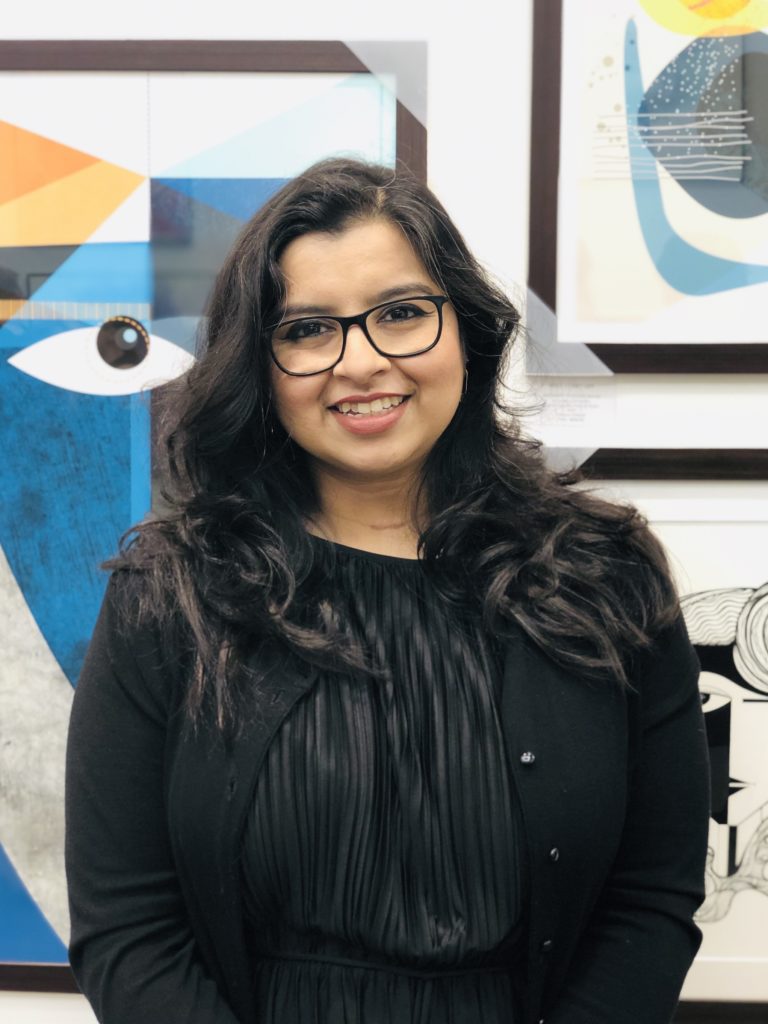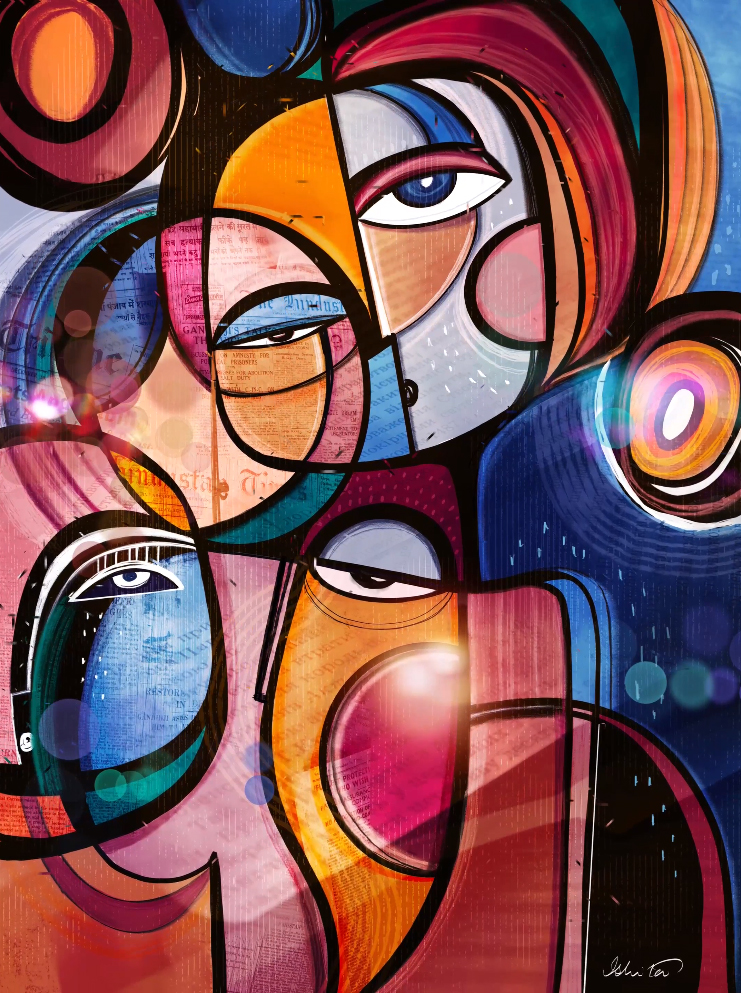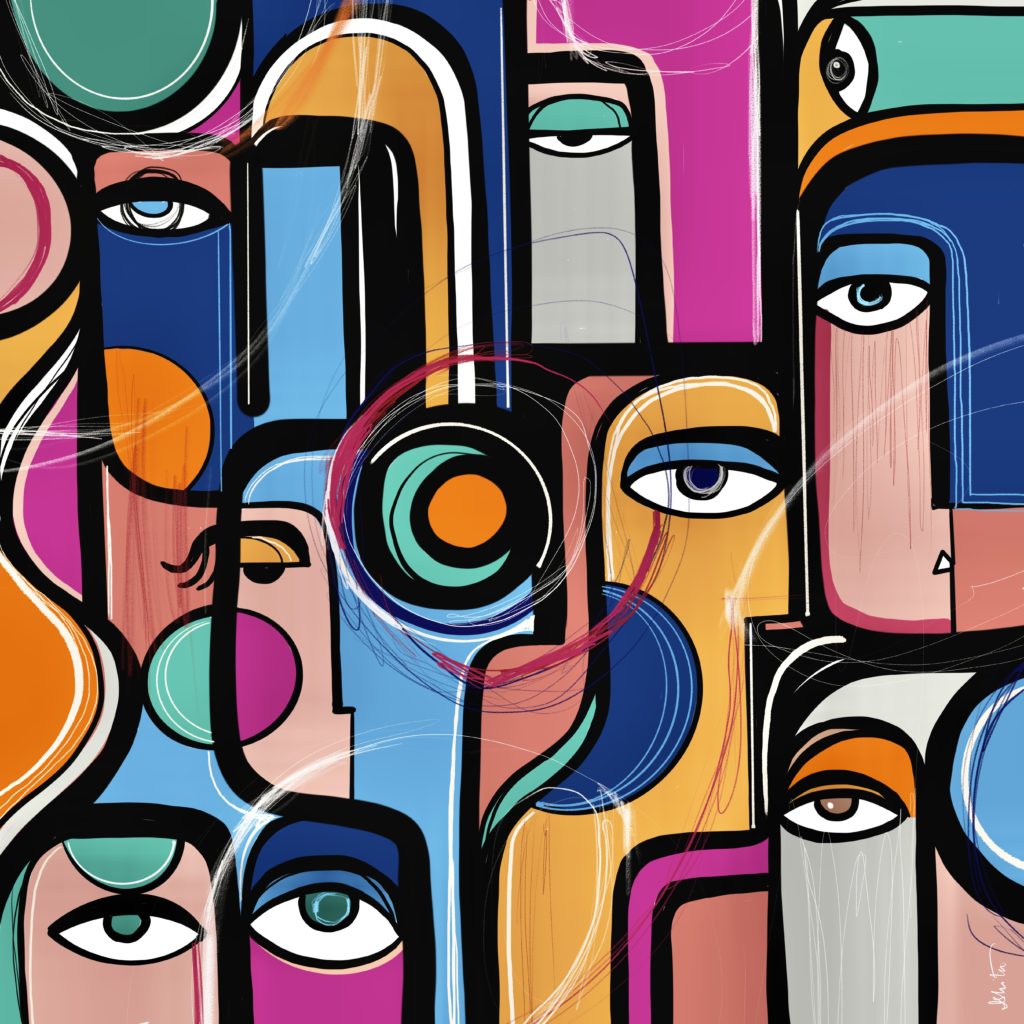Ishita Banerjee is a Canadian artist and creator. Ishita moved to Canada from India in 2010 to pursue a full-time art career under the name Soul Curry Art. With a specialization in visual narrative art. She trained as a classical fine artist. Her art is an assimilation of her life experiences, largely influenced by her relationship to impatience and impulsivity. Ishita merges imagination and memory to create vivid and bold abstracts, people, faces and non-traditional portraiture, rendered in strong colour, motifs and details. Her work is deeply inspired by the Cubist style of art, unconstrained, and breaking free of traditional rules of perspectives.

You’ve made a career in the field of broadcast design and book publishing and as a lecturer at the Delhi College of Art. How did you arrive in the visual arts?
I started my art journey by going down the traditional art school route. Pursuing a Bachelor’s in a Fine Arts degree and then a Masters in Fine Arts […] helped me delve deep into the various techniques, methods and materials of art. Art College helped sharpen my artistic instincts and also helped me understand and accept critique. Working as a lecturer in art and design opened my mind into teaching art, mentoring students and helping them to appreciate and approach design projects with an artistic vision. My many years in the broadcast design space introduced me to design software, motion design, animation and post-production techniques. I was able to visualize art concepts, branding and network designs for some of the world’s largest broadcasters. Through these experiences, I felt my art horizon-broadening and I was able to embrace multimedia experiences in my own art practice in the contemporary art space.
How did your journey with cubism begin and what attracted you to this style of art?
My final year MFA dissertation was on the sociology-cultural impacts of the Cubist art movement and that propelled me into learning deeply about the art philosophy of Cubist Art. Drawing upon Paul Cezanne’s emphasis on the underlying architecture of form, Cubists used multiple vantage points to fracture images into geometric forms. Figures were depicted as dynamic arrangements of volumes and planes where background and foreground merged. This was an aspect that fascinated me. Positive and negative spaces were unified and the same objects were broken and represented in multiple vantage points. I loved playing with the human face, breaking it apart, exploring how our narratives as humans and emotions flowed and fit into one another’s. I found myself experiencing and experimenting with this style over and over again until it became my signature style.
Where do you draw inspiration from?
Human interactions, emotions, moods, and feelings inspire my work. I love abstracting these feelings and associations. Depicting people and nature in their tempestuous forms plays a big role in my work. Actively seeking out gnarled, broken, rocky, cyclic, layered, and grungy aspects of nature, I try to find the beauty in the bizarre, the unexplained.
Through my art, I strive to give tangible forms to complex emotions like grief, longing, loss, love, suffering. The interplay of human relationships, whether with one’s own self or with others is a recurrent theme in the pieces I make. Threading lines, textures and markings in my work tell the story of the passage of time, the inter-connections of forms, both tangible and abstract.
As a woman how do you feel about your place in art history being part of an art movement traditionally occupied by men?
Cubist artwork is often associated with a very “aggressive” style and has long been a space dominated mostly by men. In my early days, working under my brand name of Soul Curry Art, many people often mistook my work to be that of a man’s. However, the universal feelings of love, longing, and loss that I explore in my artworks are free from the constraints of gender. All-encompassing abstract moods, feelings, and associations, find their way into my artworks and I soften the hard planar angles of this art form. I continue to be fearless in my use of vivid colours, bold faces, and compositional choices. I think my art perhaps is an act of striding confidently and making my presence felt in a male-dominated field.
As you moved into a digital space with your work did your process change?
I continue to straddle both traditional mediums and digital mediums in my artworks. Most often, my pieces begin on board, canvas, or paper. I work in acrylics, archival ink, gouache, and markers. I love textures, play on light, and the balance of positive and negative spaces. I use collage techniques and layer photography in some of my work as well. Some of my artworks are natively created on Procreate and I love the ease of having my studio at my fingertips with drawing and painting digitally. I’ve been able to push myself creatively after experimenting with uniquely digital artworks. Adding motion, light and music also have been a learning experience and the resulting art pieces have been a sheer joy to create.

What has your experience been so far specifically with your NFT’s featured on several platforms? Do you feel inspired to continue creating in this space?
Recently making my foray into the NFT space, I have been successful at selling my NFT’s on Foundation and OpenSea. My genesis piece “Shiva” was sold within a few days along with a number of other pieces already in the secondary market.
Being in the NFT space absolutely inspires me. It fuels a fire not just to create, but to experiment, learn, grow and evolve. Actively seeking out what I can do in this space rather than what this space can do for me, it has been a very rewarding few months, creating, connecting, and building a community. Collaborative projects and bigger ideas are what I’m working on next. Working with other artists, musicians, and developers to realize larger projects. I also want to showcase new and emerging artists from underrepresented communities, work towards curating NFT exhibitions and continue to push boundaries in my own work. I hope to never stop learning and playing through my art.

Ishita Banerjee
Website: soulcurryart.com
Instagram: @soulcurryart
Twitter: @soulcurryart



